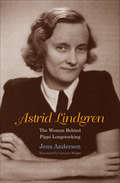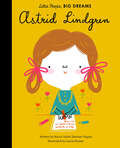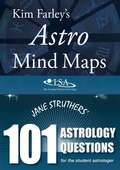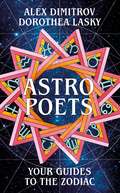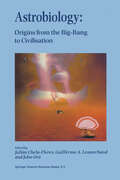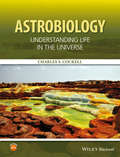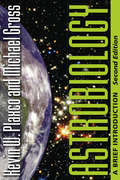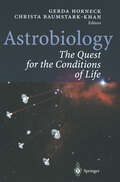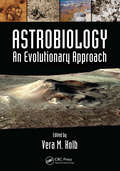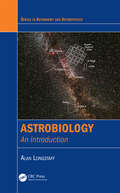- Table View
- List View
Astralabe: The Life and Times of the Son of Heloise and Abelard (The New Middle Ages)
by Brenda M. CookTwo of the most notable figures from the Middle Ages–the volatile, brilliant Abelard and the equally brilliant Heloise–became the parents of their son Astralabe before Abelard’s infamous, brutal castration. The couple spent the rest of their lives as monastics, in each other’s orbits if not in shared presence, as they became movers in the glittering monastic world of the early twelfth-century France. What happened to their strangely named Astralabe? Astralabe: The Life and Times of the Son of Heloise and Abelard rescues the “lost son” from footnotes and fiction and attempts to tell instead the story of a real man living in Europe in the twelfth century. This book assembles the references to Astralabe, provides background in the history of France and Switzerland, uncovers Abelard’s relationships with his family, with the ruling house of Brittany and more, and most importantly draws together all that is known of Astralabe.
Astrid Lindgren: The Woman Behind Pippi Longstocking
by Jens AndersenThe first English†‘language biography of Astrid Lindgren provides a moving and revealing portrait of the beloved Scandinavian literary icon whose adventures of Pippi Longstocking have influenced generations of young readers all over the world. Lindgren’s sometimes turbulent life as an unwed teenage mother, outspoken advocate for the rights of women and children, and celebrated editor and author is chronicled in fascinating detail by Jens Andersen, one of Denmark’s most popular biographers. Based on extensive research and access to primary sources and letters, this highly readable account describes Lindgren’s battles with depression and her personal struggles through war, poverty, motherhood, and fame. Andersen examines the writer’s oeuvre as well to uncover the secrets to the books’ universal appeal and why they have resonated so strongly with young readers for more than seventy years.
Astrid Lindgren (Little People, Big Dreams Ser. #43)
by Maria Isabel Sanchez Vegara<strong>In this book from the critically acclaimed, mulitmillion-copy best-selling Little People, BIG DREAMS series, discover how Astrid Lindgren grew up to become one of the world’s best-loved authors, and the creator of the irresistible Pippi Longstocking.</strong><br /> <br /> Little Astrid grew up on an old farm in Sweden. Her childhood was very happy, so happy that <strong>she never wanted to grow up</strong>. When she was four, her friend Edit read Astrid her first story. Suddenly, the entire place was filled with giants, witches and fairies.<br /> <br /> They all came out from a <strong>magic object called a book</strong>. Astrid did her best to learn how to read, and once she started, she couldn’t stop! Soon, there were no books left to borrow from the library and her friends.<br /> <br /> Learn how Astrid turned her love of books and telling stories into a career as<strong> a world-renowned author. Accessible and easy to follow text </strong>means that this book can<strong> inspire young readers </strong>in just the same way that Astrid was inspired when she started reading, all those years ago.<br /> <br /> This moving book features <strong>stylish and quirky illustrations</strong> and <strong>extra facts at the back</strong>, including a <strong>biographical timeline</strong> with historical photos and a detailed profile of the inspiring writer’s life.<br /> <br /> <strong>Little People, BIG DREAMS </strong>is a <strong>best-selling biography series for kids</strong> that explores the lives of outstanding people, from designers and artists to scientists and activists. All of them achieved incredible things, yet each began life as a child with a dream.<br /> <br /> This empowering series of books offers inspiring messages to children of all ages, in a range of formats. The <strong>board books</strong> are told in simple sentences, perfect for reading aloud to babies and toddlers. The <strong>hardcover</strong> and <strong>paperback</strong> versions present expanded stories for beginning readers. With rewritten text for older children, the <strong>treasuries</strong> each bring together a multitude of dreamers in a single volume. You can also collect a selection of the books by theme in <strong>boxed gift sets</strong>. <strong>Activity books</strong> and a <strong>journal</strong> provide even more ways to make the lives of these role models accessible to children.<br /> <br /> <strong>Inspire the next generation of outstanding people </strong>who will change the world with Little People, BIG DREAMS!<br />
Astrid Lindgren (Little People, Big Dreams Ser. #43)
by Maria Isabel Sanchez Vegara<strong>In this book from the critically acclaimed, mulitmillion-copy best-selling Little People, BIG DREAMS series, discover how Astrid Lindgren grew up to become one of the world’s best-loved authors, and the creator of the irresistible Pippi Longstocking.</strong><br /> <br /> Little Astrid grew up on an old farm in Sweden. Her childhood was very happy, so happy that <strong>she never wanted to grow up</strong>. When she was four, her friend Edit read Astrid her first story. Suddenly, the entire place was filled with giants, witches and fairies.<br /> <br /> They all came out from a <strong>magic object called a book</strong>. Astrid did her best to learn how to read, and once she started, she couldn’t stop! Soon, there were no books left to borrow from the library and her friends.<br /> <br /> Learn how Astrid turned her love of books and telling stories into a career as<strong> a world-renowned author. Accessible and easy to follow text </strong>means that this book can<strong> inspire young readers </strong>in just the same way that Astrid was inspired when she started reading, all those years ago.<br /> <br /> This moving book features <strong>stylish and quirky illustrations</strong> and <strong>extra facts at the back</strong>, including a <strong>biographical timeline</strong> with historical photos and a detailed profile of the inspiring writer’s life.<br /> <br /> <strong>Little People, BIG DREAMS </strong>is a <strong>best-selling biography series for kids</strong> that explores the lives of outstanding people, from designers and artists to scientists and activists. All of them achieved incredible things, yet each began life as a child with a dream.<br /> <br /> This empowering series of books offers inspiring messages to children of all ages, in a range of formats. The <strong>board books</strong> are told in simple sentences, perfect for reading aloud to babies and toddlers. The <strong>hardcover</strong> and <strong>paperback</strong> versions present expanded stories for beginning readers. With rewritten text for older children, the <strong>treasuries</strong> each bring together a multitude of dreamers in a single volume. You can also collect a selection of the books by theme in <strong>boxed gift sets</strong>. <strong>Activity books</strong> and a <strong>journal</strong> provide even more ways to make the lives of these role models accessible to children.<br /> <br /> <strong>Inspire the next generation of outstanding people </strong>who will change the world with Little People, BIG DREAMS!<br />
Astro-Imaging Projects for Amateur Astronomers: A Maker’s Guide (The Patrick Moore Practical Astronomy Series)
by Jim ChungThis is the must-have guide for all amateur astronomers who double as makers, doers, tinkerers, problem-solvers, and inventors. In a world where an amateur astronomy habit can easily run into the many thousands of dollars, it is still possible for practitioners to get high-quality results and equipment on a budget by utilizing DIY techniques. Surprisingly, it's not that hard to modify existing equipment to get new and improved usability from older or outdated technology, creating an end result that can outshine the pricey higher-end tools. All it takes is some elbow grease, a creative and open mind and the help of Chung's hard-won knowledge on building and modifying telescopes and cameras. With this book, it is possible for readers to improve their craft, making their equipment more user friendly. The tools are at hand, and the advice on how to do it is here. Readers will discover a comprehensive presentation of astronomical projects that any amateur on any budget can replicate – projects that utilize leading edge technology and techniques sure to invigorate the experts and elevate the less experienced. As the "maker" community continues to expand, it has wonderful things to offer amateur astronomers with a willingness to get their hands dirty. Tweaking observing and imaging equipment so that it serves a custom purpose can take your observing options to the next level, while being fun to boot.
Astro Mind Maps & 101 Astrology Questions
by Kim Farley Jane StruthersPart I: Packed with information introducing the key concepts of the horoscope, this is an ideal volume for those interested in going further than newspaper 'star signs'. Inside, you'll find: a guide to the planets, signs, elements, modes and houses; mind maps for the signs, planets and aspects; how to make the most of Mercury Retrograde; a contemporary history of the outer planets through the signs; an instant ephemeris for the outer planets; easy to use Ascendant and Midheaven calculators; and much more. Part II: Jane Struthers’ 101 Astrology Questions is packed with exercises and horoscopes tailored to ensure that student astrologers work to understand and master the essentials of astrology. This book has been designed to provide a wide range of questions intended to test and expand the reader's astrological knowledge. Includes an indispensable list of recommended reading books for the student astrologer.
The Astro Naughty Naughty Baddies
by Mark SperringThe Naughty Naughty Baddies are wickedly wicked, awfully awful and diabolically dreadful, and they have just come up with a mischievous plan to blast off to the moon and to stitch up the President. But will our fiendish fraudsters come undone?Aliens, badmobiles, rockets . . . Mwa-ha-ha! Be part of the intergalactic impishness in this astronomically funny adventure. It's out of this world!With illustrations by the bestselling illustrator of You Can't Take an Elephant on the Bus - over 150,000 copies sold in the UK.
Astro Poets: Your Guides To The Zodiac
by Dorothea Lasky Alex DimitrovFrom the online phenomenons the Astro Poets comes the first great astrology primer of the 21st century, full of insight, advice and humor for every sign in the zodiac.In these pages the Astro Poets help you see what's written in the stars and use it to navigate your friendships, your career, and your very complicated love life. If you've ever wondered why your Gemini friend won't let you get a word in edge-wise at drinks? When that Scorpio texting "u up?" at 2AM will finally take the next step in your relationship? (Hint: they won't). You've come to the right place. Both the perfect introduction to the twelve signs for the astrological novice, and a resource to return to for those who already know why their Cancer boyfriend cries during commercials but need help with their whacky new Libra boss, this is the astrology must-have for the twenty-first century and beyond.'The Astro Poets light up the internet.' The New York Times
Astro Turf: The Private Life of Rocket Science
by M. G. LordA daughter's journey to rediscover her father and understand the culture of space engineersDuring the late 1960s, while M. G. Lord was becoming a teenager in Southern California and her mother was dying of cancer, Lord's father-an archetypal, remote, rocket engineer- disappeared into his work at the Jet Propulsion Laboratory in Pasadena, building the space probes of the Mariner Mars 69 mission. Thirty years later, Lord found herself reporting on the JPL, triggering childhood memories and a desire to revisit her past as a way of understanding the ethos of rocket science. Astro Turf is the brilliant result of her journey of discovery.Remembering her pain at her father's absence, yet intrigued by what he did, Lord captures him on the page as she recalls her own youthful, eccentric fascination with science and space exploration. Into her family's saga she weaves the story of the legendary JPL- examining the complexities of its cultural history, from its start in 1936 to the triumphant Mars landings in 2004. She illuminates its founder, Frank Malina, whose brilliance in rocketry was shadowed by a flirtation with communism, driving him from the country even as we welcomed Wernher von Braun and his Nazi colleagues. Lord's own love of science fiction becomes a lens through which she views a profound cultural shift in the male-dominated world of space. And in pursuing the cause of her father's absence she stumbles on a hidden guilt, understanding "the anguish his proud silence caused both him and me, and how rooted that silence was in the culture of engineering."
Astrobiological Neurosystems: Rise and Fall of Intelligent Life Forms in the Universe (Astronomers' Universe)
by Jerry L. CranfordThis book explains why scientists believe that life may be more common in the Universe than previously considered possible. It presents the tools and strategies astronomers and astrobiologists are using in their formal search for habitable exoplanets as well as more advanced forms of life in other parts of our galaxy. The author then summarizes what is currently known about how and where organic molecules critical to our form of carbon-based life are manufactured.The core of the book explains (and presents educated guesses) how nervous systems evolved on Earth, how they work, and how they might work on other worlds. Combining his knowledge of neuroscience, computers, and astrobiology the author jumps into the discussion whether biological nervous systems are just the first step in the rise of intelligence in the Universe.The book ends with a description from both the psychologist’s and the neuroscientist’s viewpoints, exactly what it is about the fields of astrobiology and astronomy that “boggles the minds” of many amateur astronomers and interested non-scientists.This book stands out from other popular science books on astrobiology by making the point that “astro-neurobiologists” need to begin thinking about how alien nervous systems might work.
Astrobiologie
by Mathias ScholzUnter welchen Bedingungen entsteht „Leben“ und wie ist es im Kosmos verbreitet? Damit beschäftigt sich der Autor und stellt wichtige Facetten einer jungen Wissenschaftsdisziplin ausführlich vor: · Was ist und wie funktioniert „Leben“?· Entstehung des Lebens auf der Erde· Kosmische Voraussetzungen für „Leben, wie wir es kennen“· Leben im Sonnensystem und darüber hinaus· Suche nach außerirdischen ZivilisationenZudem wird das spannende Gebiet der Astrochemie behandelt, welches erklärt wie sich die molekularen Grundbausteine des Lebens unter kosmischen Bedingungen bilden. Das Buch wendet sich an interessierte Studenten der Natur- und Ingenieurwissenschaften, Abiturienten, Dozenten, Lehrer und nicht zuletzt an Amateurastronomen.
Astrobiologie - die Suche nach außerirdischem Leben
by Aleksandar Janjic"Wie können wir in diesem Jahrhundert außeridisches Leben endgültig nachweisen? Sollte es Leben in unserem Sonnensystem geben, wird es in diesem Jahrhundert gefunden werden. Mit diesem Buch wird dem Leser der aktuellste Stand der Astrobiologie verständlich vermittelt und über die heutigen und anstehenden Missionen der Raumfahrtbehörden berichtet. Kommen Sie mit auf die Reise von der Entstehung des Lebens, über die Möglichkeiten von Leben in unserem Sonnensystem, bis hin zu Exoplaneten und fernen erdähnlichen Welten, um das Phänomen des Lebens als planetaren Prozess verstehen zu können.
Astrobiologie für Einsteiger (Verdammt clever!)
by Kevin W. Plaxco Michael GroßNach einem einführenden Kapitel über die Definition von Leben beginnt die Erkundung des Themas »Leben im Universum« mit der Geschichte des Universums, unter besonderer Berücksichtigung der Umstände, die die Entwicklung von Leben ermöglicht haben. Es fokussiert dann in ähnlicher Weise auf die Geschichte unseres Sonnensystems und der Erde. Im mittleren Teil des Buchs geht es um das Leben auf der Erde: wie konnte es entstehen, sich ausbreiten, und mehr als drei Milliarden Jahre lang überleben? Welche seiner Eigenschaften sind Zufall, und welche Notwendigkeit? Im letzten Drittel des Buchs werden die Erkenntnisse aus der irdischen Biologie angewandt auf die Suche nach Leben im übrigen Sonnensystem (Mars, Monde des Jupiter und Saturn) und nach lebensfreundlichen Planeten im Rest des Universums.
Astrobiologie für Einsteiger (Verdammt clever!)
by Kevin W. Plaxco Michael GroßNach einem einführenden Kapitel über die Definition von Leben beginnt die Erkundung des Themas »Leben im Universum« mit der Geschichte des Universums, unter besonderer Berücksichtigung der Umstände, die die Entwicklung von Leben ermöglicht haben. Es fokussiert dann in ähnlicher Weise auf die Geschichte unseres Sonnensystems und der Erde. Im mittleren Teil des Buchs geht es um das Leben auf der Erde: wie konnte es entstehen, sich ausbreiten, und mehr als drei Milliarden Jahre lang überleben? Welche seiner Eigenschaften sind Zufall, und welche Notwendigkeit? Im letzten Drittel des Buchs werden die Erkenntnisse aus der irdischen Biologie angewandt auf die Suche nach Leben im übrigen Sonnensystem (Mars, Monde des Jupiter und Saturn) und nach lebensfreundlichen Planeten im Rest des Universums.
Astrobiology (Very Short Introductions Ser.)
by David C. CatlingAstrobiology is the study of the origin and development of life on this and other planets. What fascinates people about astrobiology is that it seeks answers to long-standing unsolved questions: How quickly did life evolve on Earth and why did life persist here? Is there life elsewhere in the Solar System or beyond? The research of astrobiology has become more crucial than ever in recent decades, as biologists have discovered microbes that live in ever more extreme settings, such as bubbling hot springs, in acid, or deep within rocks. Rooted in strong and rigorous research, astrobiology incorporates the work of microbiologists, geologists, and astronomers. In this Very Short Introduction, David C. Catling introduces the origins of astrobiology and demonstrates its impact on current astronomical research and potential future discoveries. ABOUT THE SERIES: The Very Short Introductions series from Oxford University Press contains hundreds of titles in almost every subject area. These pocket-sized books are the perfect way to get ahead in a new subject quickly. Our expert authors combine facts, analysis, perspective, new ideas, and enthusiasm to make interesting and challenging topics highly readable.
Astrobiology: Origins from the Big-Bang to Civilisation Proceedings of the Iberoamerican School of Astrobiology Caracas, Venezuela, 28 November– 8 December, 1999
by Julian Chela-Flores Guillermo A. Lemarchand John OróAstrobiology: Understanding Life in the Universe (Physical Chemistry In Action Ser.)
by Charles S. CockellAstrobiology is an interdisciplinary field that asks profound scientific questions. How did life originate on the Earth? How has life persisted on the Earth for over three billion years? Is there life elsewhere in the Universe? What is the future of life on Earth?Astrobiology: Understanding Life in the Universe is an introductory text which explores the structure of living things, the formation of the elements for life in the Universe, the biological and geological history of the Earth and the habitability of other planets in our own Solar System and beyond. The book is designed to convey some of the major conceptual foundations in astrobiology that cut across a diversity of traditional fields including chemistry, biology, geosciences, physics and astronomy. It can be used to complement existing courses in these fields or as a stand-alone text for astrobiology courses. Readership: Undergraduates studying for degrees in earth or life sciences, physics, astronomy and related disciplines, as well as anyone with an interest in grasping some of the major concepts and ideas in astrobiology.
Astrobiology: Understanding Life in the Universe
by Charles S. CockellAstrobiology is an interdisciplinary field that asks profound scientific questions. How did life originate on the Earth? How has life persisted on the Earth for over three billion years? Is there life elsewhere in the Universe? What is the future of life on Earth?Astrobiology: Understanding Life in the Universe is an introductory text which explores the structure of living things, the formation of the elements for life in the Universe, the biological and geological history of the Earth and the habitability of other planets in our own Solar System and beyond. The book is designed to convey some of the major conceptual foundations in astrobiology that cut across a diversity of traditional fields including chemistry, biology, geosciences, physics and astronomy. It can be used to complement existing courses in these fields or as a stand-alone text for astrobiology courses. Readership: Undergraduates studying for degrees in earth or life sciences, physics, astronomy and related disciplines, as well as anyone with an interest in grasping some of the major concepts and ideas in astrobiology.
Astrobiology: Understanding Life in the Universe (Physical Chemistry In Action Ser.)
by Charles S. CockellA guide to understanding the formation of life in the Universe The revised and updated second edition of Astrobiology offers an introductory text that explores the structure of living things, the formation of the elements required for life in the Universe, the biological and geological history of the Earth, and the habitability of other planets. Written by a noted expert on the topic, the book examines many of the major conceptual foundations in astrobiology, which cover a diversity of traditional fields including chemistry, biology, geosciences, physics, and astronomy. The book explores many profound questions such as: How did life originate on Earth? How has life persisted on Earth for over three billion years? Is there life elsewhere in the Universe? What is the future of life on Earth? Astrobiology is centered on investigating the past and future of life on Earth by looking beyond Earth to get the answers. Astrobiology links the diverse scientific fields needed to understand life on our own planet and, potentially, life beyond. This new second edition: Expands on information about the nature of astrobiology and why it is useful Contains a new chapter “What is Life?” that explores the history of attempts to understand life Contains 20% more material on the astrobiology of Mars, icy moons, the structure of life, and the habitability of planets New ‘Discussion Boxes’ to stimulate debate and thought about key questions in astrobiology New review and reflection questions for each chapter to aid learning New boxes describing the careers of astrobiologists and how they got into the subject Offers revised and updated information throughout to reflect the latest advances in the field Written for students of life sciences, physics, astronomy and related disciplines, the updated edition of Astrobiology is an essential introductory text that includes recent advances to this dynamic field.
Astrobiology: Understanding Life in the Universe
by Charles S. CockellA guide to understanding the formation of life in the Universe The revised and updated second edition of Astrobiology offers an introductory text that explores the structure of living things, the formation of the elements required for life in the Universe, the biological and geological history of the Earth, and the habitability of other planets. Written by a noted expert on the topic, the book examines many of the major conceptual foundations in astrobiology, which cover a diversity of traditional fields including chemistry, biology, geosciences, physics, and astronomy. The book explores many profound questions such as: How did life originate on Earth? How has life persisted on Earth for over three billion years? Is there life elsewhere in the Universe? What is the future of life on Earth? Astrobiology is centered on investigating the past and future of life on Earth by looking beyond Earth to get the answers. Astrobiology links the diverse scientific fields needed to understand life on our own planet and, potentially, life beyond. This new second edition: Expands on information about the nature of astrobiology and why it is useful Contains a new chapter “What is Life?” that explores the history of attempts to understand life Contains 20% more material on the astrobiology of Mars, icy moons, the structure of life, and the habitability of planets New ‘Discussion Boxes’ to stimulate debate and thought about key questions in astrobiology New review and reflection questions for each chapter to aid learning New boxes describing the careers of astrobiologists and how they got into the subject Offers revised and updated information throughout to reflect the latest advances in the field Written for students of life sciences, physics, astronomy and related disciplines, the updated edition of Astrobiology is an essential introductory text that includes recent advances to this dynamic field.
Astrobiology: A Brief Introduction
by Michael Gross Kevin W. PlaxcoInformed by new planetary discoveries and the findings from recent robotic missions to Mars, Jupiter, and Saturn, scientists are rapidly replacing centuries of speculation about potential extraterrestrial habitats with real knowledge about the possibility of life outside our own biosphere—if it exists, and where. This second edition of Kevin W. Plaxco and Michael Gross’s widely acclaimed text incorporates the latest research in astrobiology to bring readers the most comprehensive, up-to-date, and engaging introduction to the field available.Plaxco and Gross expand their examination of the origin of chemical elements, the developments that made the Universe habitable, and how life continues to be sustained. They discuss in great detail the formation of the first galaxies and stars, the diverse chemistry of the primordial planet, the origins of metabolism, the evolution of complex organisms, and the feedback regulation of Earth's climate. They also explore life in extreme habitats, potential extraterrestrial habitats, and the current status of the search for extraterrestrial life.Weaving together the relevant threads of astronomy, geology, chemistry, biophysics, and microbiology, this broadly accessible introductory text captures the excitement, controversy, and progress of the dynamic young field of astrobiology. New to this edition is a glossary of terms and an epilogue recapping the key unanswered questions, making Astrobiology an ideal primer for students and, indeed, for anyone curious about life and the Universe.
Astrobiology: The Quest for the Conditions of Life
by Gerda Horneck Christa Baumstark-KhanThis book bridges a gap in the literature by bringing together leading specialists from different backgrounds. It addresses the specific need for a readable book on this very interdisciplinary and new topic at research level.
Astrobiology: An Evolutionary Approach
by Vera M. KolbAstrobiology: An Evolutionary Approach provides a full course in astrobiology with an emphasis on abiogenesis and evolution. The book presents astrobiology both as a developing science and as the science of the future.The origins of life and the possibility of life elsewhere continues to be a subject of scientific and philosophical examination. The
Astrobiology: An Introduction (Series In Astronomy And Astrophysics Ser.)
by Alan LongstaffAstrobiology is a multidisciplinary pursuit that in various guises encompasses astronomy, chemistry, planetary and Earth sciences, and biology. It relies on mathematical, statistical, and computer modeling for theory, and space science, engineering, and computing to implement observational and experimental work. Consequently, when studying astrobio


